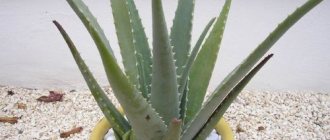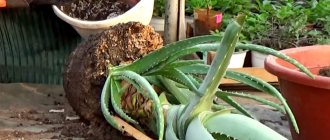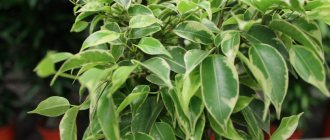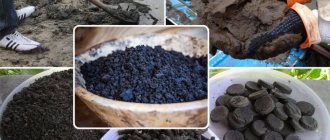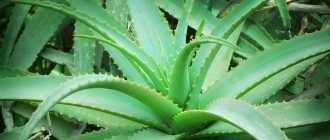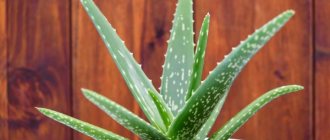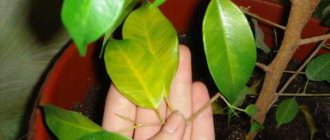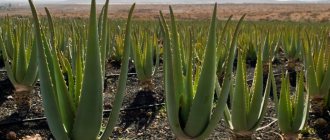Conditions for growing aloe
Aloe, also known as agave, can be grown at home if you create suitable conditions for it. Beginning gardeners should pay attention to the following points:
- Soil preparation.
- Lighting.
- Fertilizer.
- Temperature regime.
- Watering.
- Transfer.
If you care for the agave properly, the plant grows quickly and can reach a meter in height.
Soil for aloe
Under natural conditions, aloe, like a succulent, grows on sandy soil. When planting, it is necessary to prepare the soil in order to bring its composition closer to the natural environment. You need to take a ceramic pot where you place small stones for drainage.
The soil is prepared from:
1 part clay; 5 parts sand;
2 parts compost or humus.
The drainage is sprinkled with sand, and then the prepared soil is laid. Damaged roots are removed from the plant, rubbed with charcoal, the lower leaves are removed, and then carefully planted in a pot. Then the plant is watered in a circle.
Lighting
It is better to place the aloe in a lighted place. In winter he needs the sun. If the windows face north and there is not enough light, it is necessary to install special lamps.
But in summer, too much sun can cause sunburn. In the spring, the agave can be placed on the balcony so that the flower can breathe fresh air and get used to the sun's rays. In a private house, you can put the plant on the veranda.
You may be interested in: How to deoxidize the soil in the fall, methods of soil deoxidation
Watering
Don't overwater the plant. Aloe does not tolerate stagnant moisture very well, which causes the roots to rot. Water that spills after watering must be removed from the pan.
It is recommended to water the flower no more than once a week. In summer, if the soil dries out too quickly, you can change the frequency of watering.
The leaves need to be regularly freed from dust, because aloe produces phytoncides that help improve the health and purification of the air.
Temperature
It is preferable to observe the temperature regime in the room where aloe grows. In summer the temperature is 20-26°C, in the winter months about 20°C.
Aloe feeding
Normal plant development is possible only in fertilized soil. If the soil was prepared correctly during planting, then in the future you need to monitor the plant itself. Its appearance will indicate that feeding is needed.
Aloe at home. Aloe in the house: signs and magical properties of the plant
Aloe is perhaps one of the most common house plants. But few people know about its magical and healing properties. It is believed that aloe has protective magical powers and protects the house from accidents.
In Africa, the leaves of this plant are hung above the entrance to the house to ward off misfortune and attract good luck. In ancient Egypt, aloe was considered a sacred plant. It was brought as a sacrificial offering to the gods. And in the West, aloe was considered a symbol of love and faith.
How to use the magical properties of aloe in our time
- Aloe is good to have in a house where troubles often occur or household members are often sick. According to bioenergetics, constant unpleasant events in the house and frequent illnesses are a consequence of a weak biofield of space. Aloe can cleanse the house and enhance the aura around.
- To protect your home from evil people, damage and the evil eye, it is recommended to hang a dried aloe leaf over the front door.
- Aloe used to be used to make protective amulets and talismans. To do this, they took the dried roots or stems of this indoor plant and placed them in a bag. This amulet was worn around the neck or in secret pockets of clothing.
- Since aloe is considered a magical plant that attracts love, it has been used in love magic since ancient times. There is a known ritual using this flower. In order to get rid of loneliness and become attractive to the opposite sex, you need to tear off 13 aloe leaves, while mentally asking the plant for forgiveness for this. The leaves should be dried in a dark place. On the thirteenth day, the leaves must be burned and the ashes scattered in front of the threshold of the house.
- Aloe is known for its medicinal properties. Since ancient times, it has been used to heal wounds, as an anti-inflammatory agent, and to relieve pain. In China, aloe was used to treat psoriasis and smallpox. Today, aloe is used as an effective remedy against runny nose, colds, abscesses, migraines and insomnia. In order to quickly get rid of the disease, dried aloe leaves in a bag were hung around the patient’s neck.
Signs of nutritional deficiencies
A healthy plant has fleshy, deep green leaves and a strong trunk. When you cut the leaf, there will be a thick, light green juice inside.
But sometimes the tips of the leaves begin to turn yellow, and the leaves themselves become pale. The trunk becomes thin. The lower leaves fall off. The agave becomes lifeless and grows very poorly.
Why is this happening? One of the reasons is that a transplant is needed. The root system has become cramped in the pot; it lacks nutrition. They are transplanted into a larger pot or the shoots are planted in other containers. Potassium salt or ammonium nitrate is suitable as a top dressing.
It is best to purchase a complex fertilizer for succulents; it contains the optimal ratio of all useful elements. You can also prepare this fertilizer yourself by mixing minerals:
Phosphorus - 16%
Potassium - 38% Nitrogen - 5%
Recommended fertilizer composition for 5 liters of water:
- Superphosphate (0.5 g)
- Calcium sulfate (1 g)
- Ferrous sulfate (0.5 g)
- Magnesium sulfate (1 g)
- Potassium nitrate (2 g)
You may be interested in: Feeding indoor flowers with yeast: an affordable and effective fertilizer
Is it possible to use nothing?
Without additional nutrition, aloe can feel good and even grow. But if you do not replant regularly and do not apply fertilizers, then it will gradually begin to wither due to a lack of mineral components in the soil (how to replant aloe correctly?). As already mentioned, a deficiency of nutritional components affects the decorative component:
- the trunk becomes weak and thin;
- the tips of the leaves turn yellow;
- the lower leaves fall off;
- development is suspended;
- new shoots become smaller in size;
- color fades.
Some experienced gardeners prepare nutrient mixtures from available materials: banana peels, onion peels, sugar, ash. These are natural, safe products, and products made from them will not only benefit the flower, but will also save money.
Fertilizer frequency
You can apply fertilizer for the first time two months after planting. Aloe consumes minerals from the soil with each watering, and every day there are fewer of them in the pot. Fertilizer is applied in liquid form, dissolved in water.
Important! Do not allow drops of fertilizer to fall on the leaves and stem.
It is important to follow the rules for applying fertilizing so as not to harm the agave.
- Fertilizer cannot be sprayed, only water the soil with a prepared aqueous solution.
- After transplantation, plants are not fertilized for six months.
- The first feeding of store-bought agave is carried out after a month.
- Before applying fertilizer, water the plant thoroughly. When applying fertilizer to dry soil, the roots may get burned.
- If the plant is healthy, you can apply any fertilizer that is intended for succulents or cacti. They can be dry or liquid.
- If the appearance of aloe is poor, you must first determine the cause of the disease, and then select the appropriate fertilizer.
- The frequency of fertilization is once every two to four weeks in the summer. In winter, fertilizing is not carried out.
The importance of fertilizing
Gardeners and aloe lovers have experimentally found out that the active growth of a perennial plant begins with fertilizing with fertilizers. But it's not just about growth: the richer the soil, the more valuable and beneficial the aloe leaves are. And if you take into account the mainly medical use of the plant, then it immediately becomes clear why fertilizing is simply necessary.
As a rule, the soil contains enough nutrients for about six months.
But after this time it becomes depleted, and the succulent begins to starve. It appears like this:
- the aloe bush withers and decreases in size;
- loses its splendor;
- growth stops or slows down significantly;
- color fades;
- the likelihood of contracting “plant diseases” increases.
To avoid all this, you just need to feed the plant on time, not letting it starve.
Application of ready-made fertilizers
Agricola. This is a dry fertilizer and must be diluted with water before application. It contains a whole complex of microelements. The use of Agricola is effective at any stage of growing agave. It is used for root feeding. The mixture is prepared according to the instructions. Etisso. This fertilizer promotes rapid plant growth. It contains iron, copper and other trace elements. It is not recommended to apply it after transplantation. If you apply fertilizer too quickly, your aloe may become sick.
Bona forte. The concentrated liquid fertilizer contains succinic acid and other substances that affect the process of photosynthesis. You can carry out root feeding once every 7 days. The solution is prepared, dissolve in 5 ml/1.5 l of water. Foliar feeding is carried out with a liquid solution (5 ml/3 l of water). It is better to use the prepared solution within 14 days, otherwise it will lose its properties.
The power of life. Fertilizer needed for balanced nutrition and strengthening the root system. The solution is sold in concentrated form; before use it must be diluted according to the instructions. You should not use fertilizer for foliar feeding, but for root feeding it is enough to dissolve a teaspoon of the mixture in 10 liters of water.
Pokon. Dry fertilizer is popular and needs to be diluted in water before use. It is rarely used for spraying; more often it is used to water the soil. Watering aloe once every two weeks, the mixture is diluted in a ratio of 10 ml/1 liter of water.
Green World. Complex liquid fertilizer. Necessary for the development of the root system and strengthening of the leaves. It is able to regulate water balance, which is necessary for the leaves to be fleshy. Uniflor cactus. This is a liquid fertilizer that affects the formation of thorns. Used as root feeding.
Traditional recipes for fertilizing aloe
Egg shells. It is dried and crushed. Shells can reduce the acidity of the soil. It decomposes over time, so you should not get carried away with such fertilizing.
Sugar. Once a week, you should sprinkle a little sugar on the surface and water the aloe well.
Onion peel. Helps destroy bacteria and pest larvae. To prepare the infusion, add 25 g of husks to 6 liters of hot water. Then the mixture is infused for several days. Then it is filtered and used to spray the plant.
indoor plants, feeding
